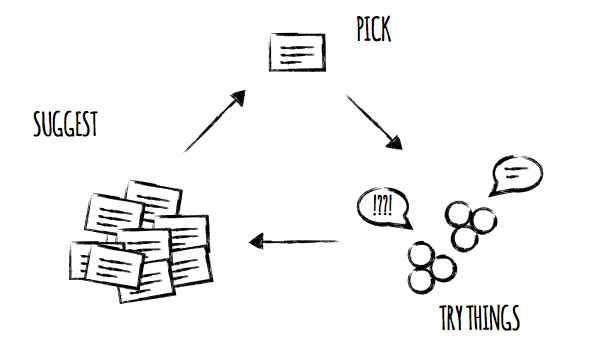I've always been a tinkerer. I value understanding different things. Even if the net result is "eugh that's a terrible idea". I enjoy challenging my assumptions and opinions because being proven wrong means I've learnt something and that's good. And while I may never use the language or tech I've tinkered with there may well be principles or practises I can apply to whatever I'm doing presently. Generalism is in my blood. But tinkering can be a lonely old game, finding like minded people wanting to tinker with the same things with the same availability is a thankless task.
It's time to try something new - it's time to Try Things. Try Things is a hands-on meet up format aimed at the technically curious.
How It Works

Try Things is a relatively informal concept but the general flow of an event is outlined below. It is a technically focused event so a computer is somewhat essential for attendees.
Pre Event
First things first you'll need a backlog of topics/suggestions. Write an app, use Trello, index cards, suggestion box, email, it doesn't matter really. Topics can be anything really,
- An emerging language like Elixir or Clojure
- A new database technology like RethinkDB or Datomic
- A new build tool like SBT
- An architectural concept like Single Page Applications
- An idea like mobile time tracker
Kicking off the Event
Duration is entirely open but a good 3-4 hour window provides a perfect buffer, though if you are a particularly effective driver then I'm sure 2 hours is great.
Once people are gathered and settled one of the previously submitted topics are selected at random. If you want to turn the randomness down a tad you can also use a bit of consensus voting. First randomly picked topic to get a majority thumbs up is your topic for the event.
Challenge Setting
Depending on the topic there may be goals, challenges or questions that the participants may have. Perhaps different people want to look at different aspects of the topic, maybe they want to approach the topic in a different way or perhaps they simply thirst for competition. Before the main part of the event kicks off people should quickly share what they know about the topic, raise any interesting questions and highlight any learning goals they want to get out of it. These should be recorded in some manner to allow the participants to reflect back after they've finished hacking.
The Hack
Once people are happy and if necessary divided into teams everyone gets to the hacking. Its important to keep the communication open at this point as you don't want people going back into their caves during this time. This is supposed to be a social thing remember. A few things to promote the social side,
- Have a vocal facilitator doing the rounds and highlighting interesting discoveries
- Scheduled coffee breaks to allow people to lift their head above the screen and flex their vocal chords
- Team rotation
Wrap Up
Once the hacking has come to some satisfactory conclusion or designated deadline it's time to share what we've learnt. This can be simple show and tells or checking our progress against the initial objectives/challenges.
The end result isn't supposed to be a black and white "yeah I'll use this thing again", it's supposed to be a shared learning experience and provide an avenue for people to work on things they may not get a chance to in their daily work.
The Next Step
I'm intend to run a few Try Things sessions over the next few months in London and Belfast (dates and locations still TBD) so if this seems like your sort of thing and would be interested in attending, or if you have any suggestions (or maybe you just like the potential of free beer) - please let me know on Twitter (@kouphax)